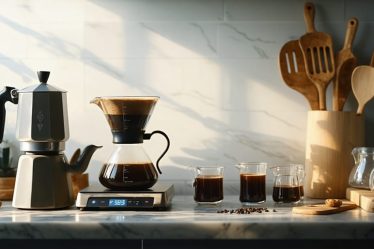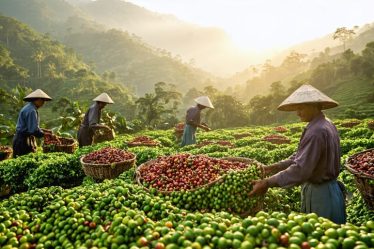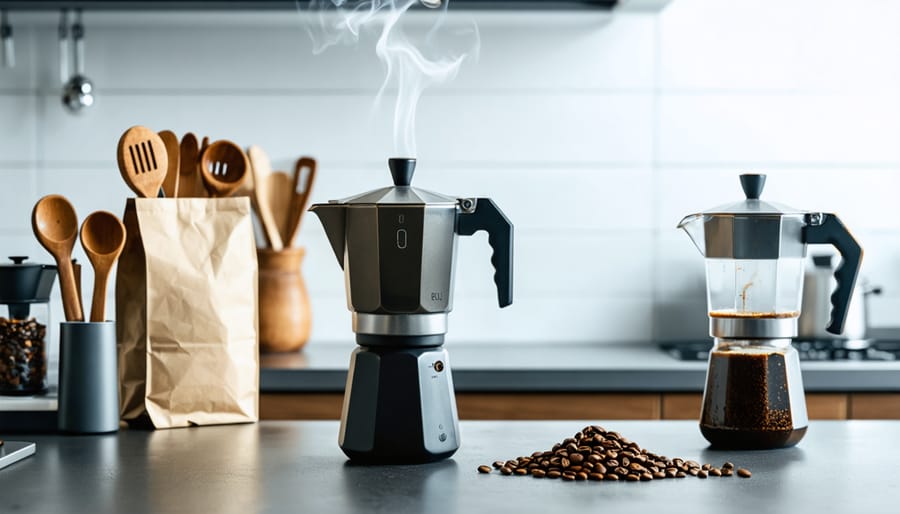
Transform your morning brew into a barista-worthy experience by mastering the ideal coffee-to-water ratio. Using 8 cups of water (64 ounces) requires precisely 16 tablespoons (or 1 cup) of ground coffee to achieve that perfect balance of strength and flavor. While this 1:16 ratio serves as the golden standard for perfect coffee brewing techniques, feel free to adjust slightly based on your taste preferences. For optimal results, use filtered water at 200°F and freshly ground beans, allowing the full spectrum of flavors to shine through. Whether you’re brewing for a crowd or meal prepping your coffee for the week, this ratio ensures consistently delicious results that rival your favorite café’s offerings. Remember, the quality of your water matters just as much as your beans – it makes up 98% of your coffee, after all!
Understanding the Standard 8-Cup Measurement
Coffee Pot vs. Standard Cup Measurements
Here’s something I learned the hard way during my early coffee-making adventures: a “cup” in your coffee maker isn’t the same as the measuring cup in your kitchen! While a standard measuring cup holds 8 fluid ounces, most coffee makers consider a cup to be just 5-6 ounces. This explains why that “8-cup” coffee maker might seem to brew less than expected.
Think of it this way: when your coffee maker says it makes 8 cups, it’s actually producing about 40-48 ounces of coffee, not 64 ounces as you might expect with standard measuring cups. I always recommend checking your coffee maker’s manual for its specific cup measurement – it’ll save you from any morning coffee disappointments!
For the most accurate brewing, consider using the carafe’s markings rather than your kitchen measuring cups. This small detail makes a big difference in achieving that perfect pot of coffee every time.
Converting Between Different Measurements
Let’s make those coffee measurements a breeze! When I first started brewing coffee at home, I was constantly googling conversions, but now I’ve got them down to a science. For 8 cups of water (which is 64 fluid ounces), you’ll want to use about 16 tablespoons or 1 cup of ground coffee – this follows the golden ratio that many coffee lovers swear by.
If you prefer working with milliliters, 8 cups equals approximately 1,892 milliliters of water. Here’s a quick cheat sheet I keep handy: 1 cup equals 8 fluid ounces or 237 milliliters. For precision brewing, especially when trying new recipes, I love using a kitchen scale to measure my coffee in grams – aim for about 85-95 grams of ground coffee for your 8 cups of water.
Remember, these measurements are starting points – feel free to adjust based on your taste preferences. Trust me, once you get comfortable with these conversions, you’ll be brewing perfect coffee without even thinking about it!

Water Quality Essentials for Perfect Coffee
Mineral Content and Coffee Extraction
You know, one of my biggest coffee revelations came when I learned that the minerals in our water play a huge role in how our morning brew tastes. The water quality impacts on coffee are actually quite fascinating – it’s not just about the beans!
Think of minerals like calcium and magnesium as tiny flavor ambassadors. They help extract those delicious compounds from your coffee grounds, giving you that perfect cup you’re craving. Too few minerals (like in distilled water), and your coffee might taste flat and uninspiring. Too many, and you could end up with an overly harsh or bitter brew.
I’ve found that moderately hard water tends to work best for most coffee brewing methods. It has just the right amount of minerals to bring out those lovely coffee notes without overwhelming them. If you’re using tap water, you might notice that your coffee tastes different from what you’ve had at your favorite café – that’s those minerals at work!
For the best results, try using filtered water that still retains some mineral content. This gives you more control over your brew while ensuring those helpful minerals are present to extract all the goodness from your coffee grounds. Trust me, once you start paying attention to your water quality, you’ll notice a remarkable difference in your daily cup!
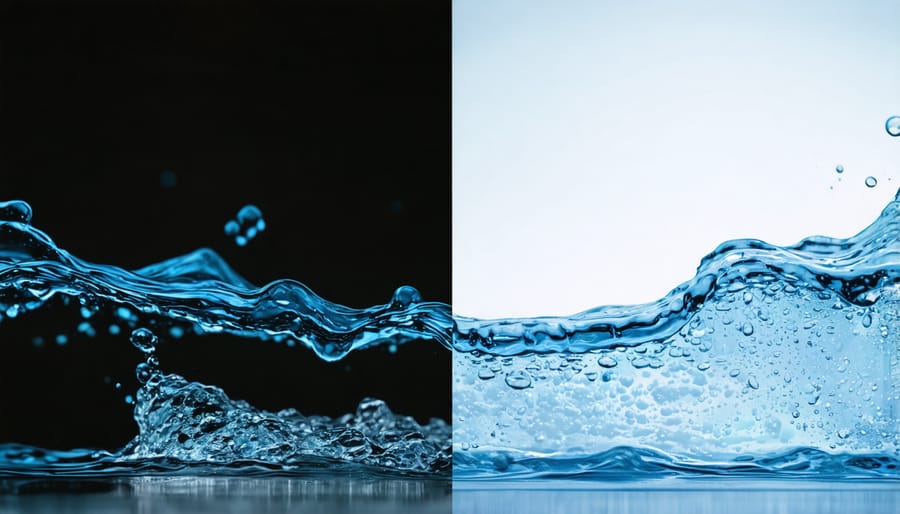
Filtered vs. Tap Water for Coffee
You know that moment when you take your first sip of coffee and something just feels… off? I discovered that the secret to consistently great coffee often lies in the water we use. After years of experimenting (and some questionable cups of coffee), I’ve learned that filtered water can make a remarkable difference in your daily brew.
Think of water as the canvas for your coffee masterpiece. Tap water, while convenient, often contains minerals and chemicals that can interfere with the delicate flavors in your coffee beans. Have you ever noticed a slight chlorine taste in your morning cup? That’s your tap water making its presence known!
Filtered water, on the other hand, provides a clean, neutral base that allows your coffee’s true character to shine through. It removes impurities while maintaining the perfect balance of minerals that actually enhance coffee extraction. I’ve found that using filtered water results in a smoother, more aromatic cup with none of those unwanted undertones.
But here’s the thing – you don’t need to invest in an expensive filtration system. A simple pitcher filter works wonderfully for coffee brewing. If you’re using tap water now, try this little experiment: make two identical batches of coffee, one with tap water and one with filtered water. The difference might surprise you!
Remember, great coffee is all about the details, and the water you choose is just as important as those perfectly measured coffee grounds.
Getting Your Coffee-to-Water Ratio Right
The Golden Ratio for Different Coffee Types
You know how everyone has their perfect cup of coffee? Well, let me share my favorite ratios for different brewing methods – they’re total game-changers! For a classic drip coffee maker (which is what I use on busy mornings), aim for 2 tablespoons of ground coffee for every 8 ounces of water. If you’re brewing 8 cups, that means you’ll need about 16 tablespoons of coffee.
For those who love their French press (like my sister swears by), go a bit stronger with 2.5 tablespoons per 8 ounces of water. That means for 8 cups, you’re looking at about 20 tablespoons of coffee grounds. Trust me, it makes the most luxurious, full-bodied brew!
If you’re into pour-over coffee, stick to the golden ratio of 2 tablespoons per 8 ounces, but feel free to adjust slightly based on your taste. Some of my friends prefer it a touch stronger, using 2.25 tablespoons per cup.
For cold brew lovers, you’ll want to use more coffee – about 3 tablespoons per 8 ounces of water. When making a big batch with 8 cups of water, that’s 24 tablespoons of coffee grounds. Remember, cold brew is usually diluted later, so don’t worry if this seems strong!
The beauty of these ratios is that they’re starting points – feel free to tweak them until you find your perfect cup!
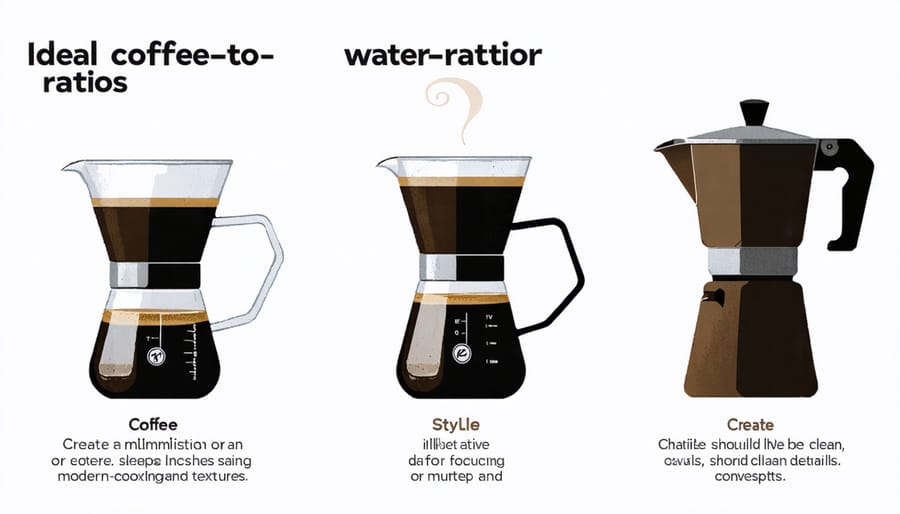
Common Mistakes and How to Avoid Them
Let’s talk about those coffee-making mishaps we’ve all experienced! I’ve certainly had my share of brewing blunders, and I’m here to help you avoid the most common water-related mistakes that can turn your morning brew into a disappointment.
First up is using water that’s too hot. I learned this the hard way when my coffee turned out bitter and harsh. Following proper brewing temperature guidelines makes a world of difference in taste.
Another frequent mistake is eyeballing your measurements. Trust me, “close enough” usually isn’t! Using too much water dilutes your coffee, while too little creates an overly strong brew. Always measure both your water and coffee grounds precisely for consistent results.
Watch out for using tap water straight from the hot faucet. This water often contains more dissolved minerals and can affect your coffee’s taste. Instead, start with cold, filtered water and heat it to the right temperature.
Also, don’t forget to adjust your measurements based on your coffee maker. Different brewing methods might require slightly different ratios. For example, a French press typically needs coarser grounds and might work better with slightly less water than a drip machine.
Lastly, remember that old water sitting in your kettle or coffee maker can make your coffee taste stale. Always start with fresh, cold water for the best results.
Now that we’ve explored the perfect coffee-to-water ratio, you’re ready to brew your ideal cup of coffee! Remember, for those 8 cups of water in your coffee maker, you’ll want to use 16-20 tablespoons (or about 1 to 1.25 cups) of ground coffee, depending on how strong you like your brew. I’ve found that starting with 18 tablespoons usually hits that sweet spot that most coffee lovers enjoy.
Keep in mind that every coffee journey is personal, and it’s totally okay to adjust these measurements to suit your taste. Start with our suggested ratio and tweak it slightly until you find your perfect balance. Quality matters just as much as quantity – always use fresh, filtered water and properly stored coffee grounds for the best results.
Don’t forget to clean your coffee maker regularly and measure your ingredients carefully. These small details make a huge difference in your final brew. And remember, while these measurements work perfectly for a standard drip coffee maker, you might need to adjust slightly for different brewing methods.
Happy brewing, coffee lovers! With these guidelines in hand, you’re all set to create that perfect pot of coffee that’ll make your mornings absolutely delightful.


